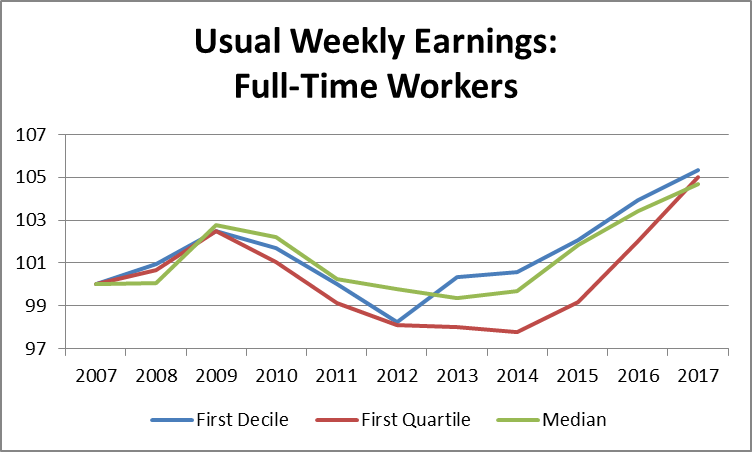January 20, 2018
The Bureau of Labor Statistics released its eagerly awaited data on usual weekly earnings for the 4th quarter last week. The data for the 4th quarter were actually not very good, but the quarterly data are erratic. If we look at the full year data, we get a pretty good story. Real median weekly earnings were up 1.2 percent. Earnings for workers at the cutoff for the first quartile (earning more than 25 percent of workers and less than 75 percent) were up 2.9 percent. For workers at the cutoff for the first decile (earning more than 10 percent of workers and less than 90 percent), earnings were up 1.4 percent.
This means we have seen three years of pretty decent wage growth for those at the middle and bottom of the wage distribution. Here’s the picture since the Great Recession began in 2007.

Source: Bureau of Labor Statistics.
In the last three years, earnings for the median worker have risen by 5.3 percent, for workers at the first quartile cutoff 7.1 percent, and by 5.0 percent at the first decile cutoff. This is pretty good evidence of the effect that a tight labor market has on the earnings of workers at the middle and bottom of the pay ladder. Even low-paying employers are finding that they have to raise wages to get and keep workers. (Note that this is all before the impact of the Trump tax cuts.)
This shows the importance of keeping the Fed from raising interest rates aggressively. There were many economists, including some at the Fed, who argued that the Fed should have raised interest rates to keep the unemployment rate from dipping much below 5.5 percent or 5.0 percent. With an unemployment rate now at 4.1 percent, not only do millions more workers have jobs, but tens of millions have higher pay because they have more bargaining power in the labor market.
One final point: while the last three years do look like good news for the bottom half of the labor market, we shouldn’t spend too much time celebrating. We’re still looking at a decade in which real wage growth has averaged just 0.5 percent annually. And this follows three decades of wage stagnation for the bottom half of the labor market. That is not a happy story, even if things are moving in the right direction now.







Comments